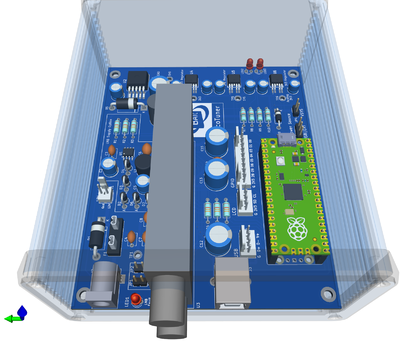Difference between revisions of "PicoTuner Hardware"
| Line 21: | Line 21: | ||
That completes the testing, but it won't work yet until the NIM is fitted, so do that next. Be careful not to bend any pins on installing it, it should be an easy fit, if it isn't something is wrong. Make sure it is straight and properly seated, then solder the tabs. Only solder the pins after checking everything is correctly placed. | That completes the testing, but it won't work yet until the NIM is fitted, so do that next. Be careful not to bend any pins on installing it, it should be an easy fit, if it isn't something is wrong. Make sure it is straight and properly seated, then solder the tabs. Only solder the pins after checking everything is correctly placed. | ||
| − | That's it. However, if you plan to use the USB port, you need to make up a patch lead. The best way is to cut up a good quality micro-USB cable. The pinout is marked on the silk screen. | + | That's it. However, if you plan to use the USB port, you will need to make up a patch lead. The best way is to cut up a good quality micro-USB cable. The pinout is marked on the silk screen. The "standard" is Red V+, Green D+, White D- and Black GND. |
| − | |||
Revision as of 17:58, 28 March 2024
Mike G0MJW has designed a PCB which will host the Serit NIM and Pico board.
PCBs will be made available in the shop during April 2024.
The schematic is available here File:PicoTunerFinal.pdf
Draft BOM is available here: File:PicoTunerADJBOM.xlsx
Construction is straight forward and best done according to the height of the components being fitted.
The LNB supply chip, if used, is the most challenging as it is an SMD device and has a pad on the base that needs to be soldered to the groundplane. So, start with this. First solder the chip pins to the PCB, taking care to get it in the correct place. When happy, with a large soldering iron, heat the pad and poke some solder through the hole on the reverse side of the PCB intended for this purpose. Do not use too much solder. It's not hard if you take care, but note a cheap, small 25W iron wont work. Use the correct tools.
I would then progress with U4, U5 and U6, ensuring to get them in the right places, then the resistors, then D8, U1, D1, D2, the pin-headers JP1, 2 3 & 4, the DC socket and USB socket, the pin-sockets for the pico (not optional, trust me, you will need to remove it at some point), the ceramic capacitors the remaining diodes, C1, C5, the LEDs, the fuse holder, molex connectors and finally the electrolytics. If this were SMD it would take about 30 minutes but with it being through hole probably about 2 hours due to constant requirement to invert the board and search the bench and floor for the components that fell out.
Note, do not install the NIM yet. The first thing to do is test the regulators, starting with U1. Select external and power from 12V. Remember to fit the fuse and JP1. There should be 4.3-4.5V at TP3. There will be no supply to the rest of the regulators until JP4 is selected. However, as the regulators are not enabled there will be no output. To get an output it is necessary to temporarily short pins 1&2 on U4 or U6. This sets the enable pin high and the correct voltages should appear on TP4, TP5 and TP6. Once tested, remember to remove the short.
If all is OK, fit the Pico and move the supply JP4 to USB. Connect the Pico to a USB port and repeat the testing for TP4, TP5 and TP6. You may also want to install the firmware - see below.
That completes the testing, but it won't work yet until the NIM is fitted, so do that next. Be careful not to bend any pins on installing it, it should be an easy fit, if it isn't something is wrong. Make sure it is straight and properly seated, then solder the tabs. Only solder the pins after checking everything is correctly placed.
That's it. However, if you plan to use the USB port, you will need to make up a patch lead. The best way is to cut up a good quality micro-USB cable. The pinout is marked on the silk screen. The "standard" is Red V+, Green D+, White D- and Black GND.
Programming the Pico
This can be done either before or after the Pico has been fitted to the PCB, it makes no difference. Updating to a new firmware version is done the same way.
1. Locate the latest compiled firmware file 'PicoTuner_vxxx.uf2' which will be found here https://github.com/g4eml/PicoTuner/releases and save it to your desktop.
2. Hold down the BOOTSEL button on the Pico while connecting it to your PC using its micro USB port. The Pico should appear as a USB disk drive on your PC.
3. Copy the .uf2 file onto the USB drive. The Pico will recognise the file and immediately update its firmware, reboot and the PC should recognise a new USB device.
